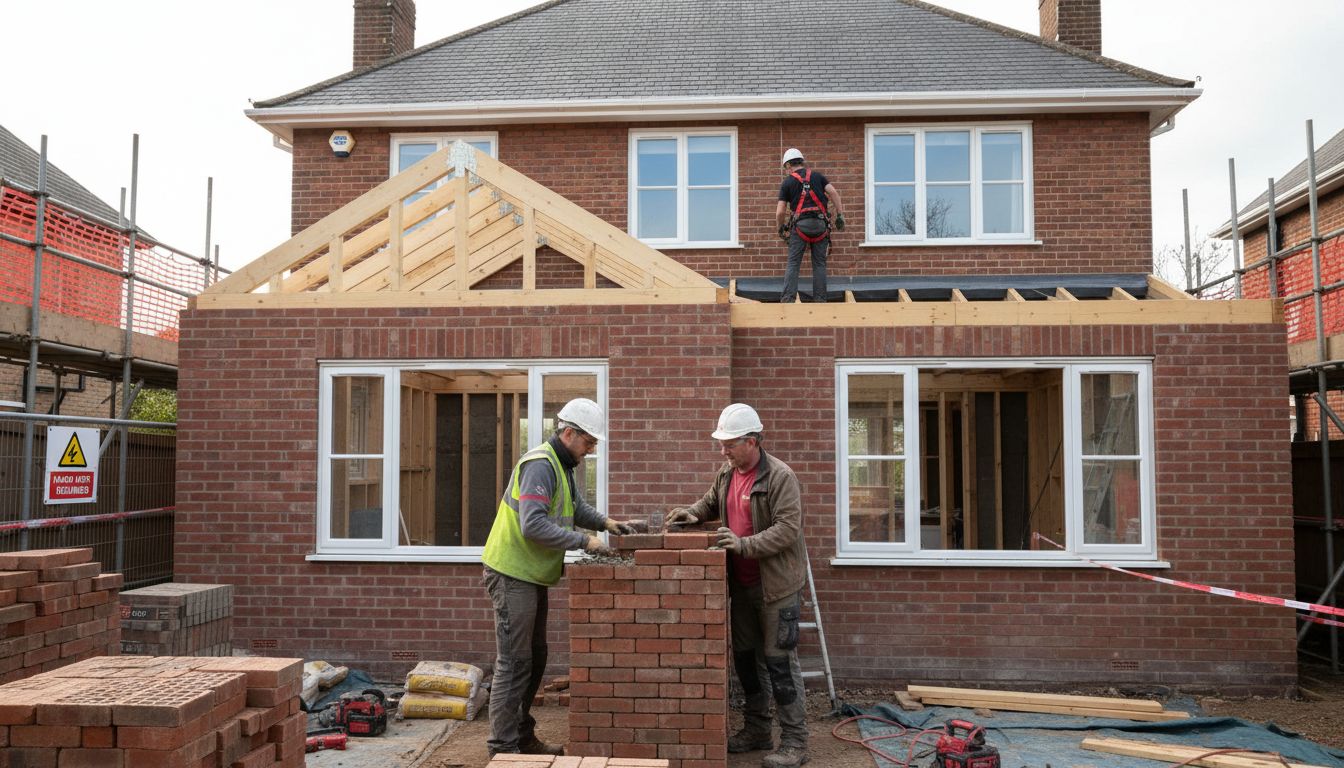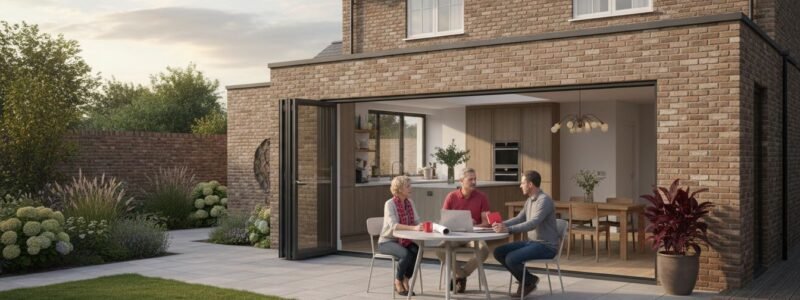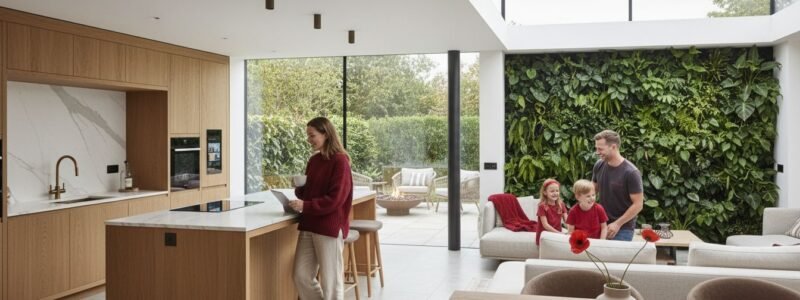Did you know that a well-designed rear extension can add up to 20% to your home’s value? More homeowners are choosing to improve, not move, by expanding their living spaces in creative ways. With the right approach, you can transform your property with light-filled rooms, open-plan layouts, and modern features that fit both your style and needs. Discover how thoughtful extensions offer more space, greater comfort, and a smart investment for the future.
Table of Contents
- Defining Rear Extensions And Key Concepts
- Popular Rear Extension Designs And Variations
- Maximising Usable Space And Home Value
- Planning Permission And Building Regulations
- Cost Factors And Return On Investment
Key Takeaways
| Point | Details |
|---|---|
| Rear Extensions Enhance Living Space | These architectural additions can significantly improve home functionality and aesthetics while potentially increasing property value by up to 20%. |
| Design Variety Accommodates Needs | Homeowners can choose from a range of rear extension styles to suit their lifestyle, including contemporary open-plan layouts and traditional designs. |
| Planning and Compliance are Essential | Understanding local regulations and building codes is crucial for securing necessary approvals and ensuring compliance throughout the construction process. |
| Budgeting Impacts Investment Return | Thoroughly planning financial aspects, including design and materials, can transform a rear extension into a valuable long-term asset for homeowners. |
Defining Rear Extensions and Key Concepts
A rear extension transforms the back of your home by adding new living space, typically expanding areas like kitchens or living rooms. According to reading.gov.uk, these architectural additions involve strategically constructed structures that complement the original building’s design while increasing functional space.
The core purpose of rear extensions is spatial enhancement. Urbanist Architecture highlights that these projects can feature diverse architectural styles, including variations in roof design such as:
- Flat roofs offering modern, minimalist aesthetics
- Pitched roofs providing traditional architectural character
- Skylights to maximise natural light penetration
When considering a rear extension, homeowners should evaluate several critical factors. These include maintaining architectural harmony with the existing structure, understanding local planning regulations, and selecting appropriate building materials. The goal is not just additional square footage, but creating a seamless, functional space that enhances your home’s overall livability and potential market value.
For comprehensive guidance through this complex process, check out our guide on understanding rear extension planning.
Popular Rear Extension Designs and Variations
Homeowners have numerous creative options when designing rear extensions, each offering unique ways to transform living spaces. According to the Federation of Master Builders, popular designs include open-plan kitchen-diners with strategically placed skylights, rear lounges featuring Crittall-style doors, dedicated home offices, and versatile wraparound extensions that maximise available space.
Self Build emphasises contemporary approaches to rear extensions, highlighting design trends that blur indoor and outdoor boundaries. These modern interpretations typically incorporate:
- Large glazed doors creating seamless transitions
- Timber cladding for natural aesthetic appeal
- Open-plan layouts promoting fluid living spaces
- Minimalist architectural elements
The diversity of rear extension designs allows homeowners to personalise their space according to specific lifestyle needs. Whether you’re seeking additional kitchen space, a home office, or a light-filled living area, there’s a rear extension style to suit every architectural preference. For more inspiration and detailed insights into extension possibilities, explore our types of home extensions guide.

Here’s a comparison of popular rear extension design options:

| Design Feature | Traditional Rear Extension | Contemporary Rear Extension | Wraparound Extension |
|---|---|---|---|
| Roof Style | Pitched | Flat | Pitched Flat Hybrid |
| Key Materials | Brick Tile | Glazed panels Timber | Brick Glass Render |
| Lighting Solutions | Standard windows | Skylights Large doors | Skylights French doors |
| Layout Approach | Separate rooms | Open-plan | Fluid multi-use spaces |
| Indoor-Outdoor Flow | Limited | Seamless Wide openings | Integrated Corner access |
| Best Use Case | Extra lounge/kitchen | Modern kitchen-diner | Maximum space expansion |
Maximising Usable Space and Home Value
Rear extensions represent a strategic investment for homeowners looking to enhance both living space and property marketability. Kent Lofts reveals that well-executed extensions can potentially increase home value by up to 20%, making them a compelling alternative to costly relocations.
The Federation of Master Builders emphasises that successful rear extensions do more than simply add square footage. They can fundamentally transform a home’s functionality by:
- Improving internal spatial flow
- Creating multifunctional living areas
- Enhancing natural light penetration
- Modernising dated property layouts
Key design considerations that maximise both usability and value include integrating flexible living spaces, incorporating high-quality materials, and ensuring seamless architectural integration with the existing structure. Thoughtful extensions not only provide immediate lifestyle benefits but also represent a smart long-term property investment. For homeowners seeking to unlock their property’s potential without moving, explore our guide to smart home extensions to discover how strategic improvements can transform your living environment.
Planning Permission and Building Regulations
Navigating the complex landscape of planning permission requires careful understanding of local regulations and development rights. Kent Lofts highlights that many rear extensions can actually be undertaken under Permitted Development Rights, which allow single-storey extensions up to 6 metres for semi-detached homes and 8 metres for detached properties, subject to prior approval.
Local planning policies play a crucial role in determining extension feasibility. According to Reading City Council, rear extensions must meet specific criteria to gain approval:
- Remain subordinate to the original dwelling
- Utilise matching external materials
- Avoid adverse impacts on neighbouring properties
- Maintain architectural harmony with existing structures
Building Regulations compliance is mandatory and covers critical aspects of construction, including:
- Structural integrity
- Fire safety standards
- Energy efficiency requirements
- Thermal insulation specifications
- Drainage and ventilation protocols
For homeowners seeking clarity on the often intricate process of obtaining necessary approvals, our comprehensive guide to planning permission provides detailed insights into navigating these regulatory requirements effectively.
Cost Factors and Return on Investment
Understanding the financial landscape of rear extensions is crucial for homeowners considering property improvements. Kent Lofts provides detailed insights into the financial considerations, revealing that single-storey extensions typically range from £1,800 to £2,500 per square metre. These costs encompass not just construction, but additional expenses such as:
- Architectural design fees
- Structural calculation charges
- Council application expenses
- Professional consultant costs
The Federation of Master Builders emphasises that well-designed rear extensions represent more than just a construction project. They are strategic investments that can significantly enhance property value by creating functional living spaces tailored to modern homeowner needs. Key factors influencing overall investment include:
- Quality of design and materials
- Architectural integration
- Potential increase in property market value
- Long-term functional improvements
Budgeting carefully and prioritising design quality can transform a rear extension from a mere construction project into a valuable long-term asset. For personalised insights into maximising your extension’s financial potential, explore our smart home investments guide.
Transform Your Living Space with Expert Rear Extensions
If you have been exploring ways to maximise your home’s living area through a rear extension you understand the importance of thoughtful design combined with professional project management. Common challenges include ensuring your extension complements your existing structure while enhancing natural light and functionality. At Reltic Extend, we specialise in creating bespoke rear extensions that seamlessly blend modern style with practical living solutions. With over 20 years of trusted experience, we manage every phase from securing planning permission to delivering craftsmanship with a 10-year structural warranty.
Discover a variety of Types of Home Extensions & Ideas that suit your lifestyle and property. Our Design & Build Tips for Home Extensions provide insights to help you visualise your perfect extension. Ready to start maximising your living space without the stress of moving? Contact us today at Reltic Extend to arrange a consultation and take the first step towards transforming your home into a stylish, spacious haven.
Frequently Asked Questions
What is a rear extension?
A rear extension is an architectural addition to the back of a home, designed to expand living space, often encompassing areas like kitchens or living rooms.
What are the popular designs for rear extensions?
Popular designs for rear extensions include open-plan kitchen-diners with skylights, dedicated home offices, and contemporary wraparound extensions that increase available space while enhancing natural light.
Do I need planning permission for a rear extension?
Many rear extensions can be constructed under Permitted Development Rights, allowing certain sizes without formal permission. However, specific local planning regulations should be checked to ensure compliance.
How much does a rear extension typically cost?
The cost of a rear extension generally ranges from £1,800 to £2,500 per square metre, which covers construction costs and additional fees like architectural designs and council applications.





